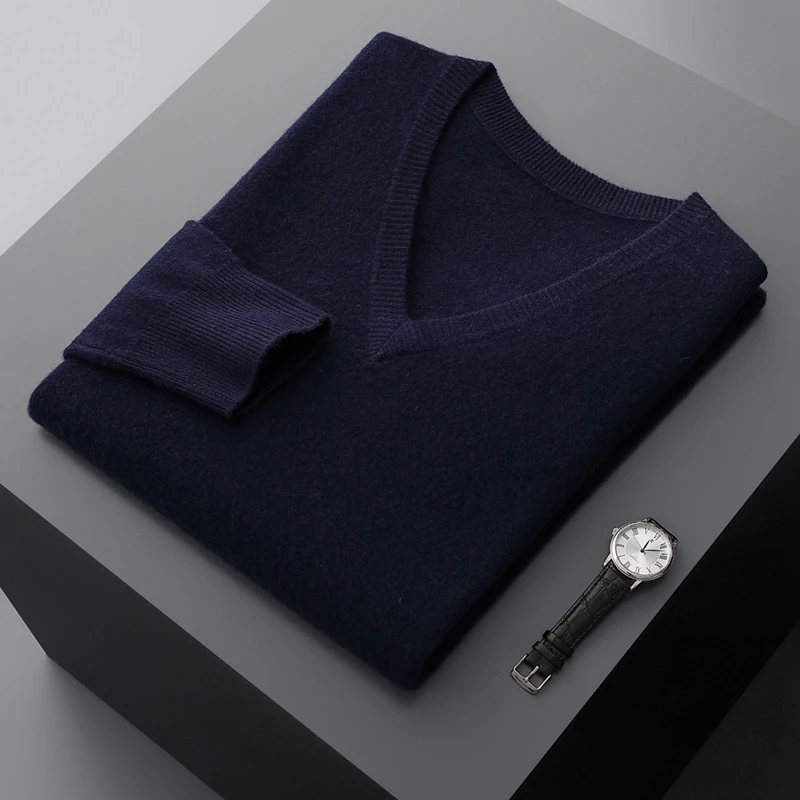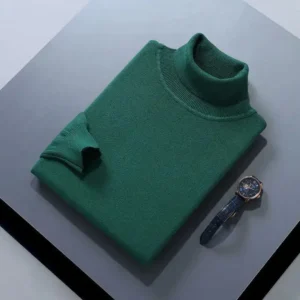Introduction: Decoding Cashmere’s Hidden Quality Indicator
When you run your fingers across a luxurious cashmere sweater, there’s more to its exceptional feel than meets the eye. Behind every premium cashmere garment lies a secret language of quality – the gauge number. This often-overlooked specification speaks volumes about how a piece will feel, function, and endure over time.
For cashmere enthusiasts and quality-conscious shoppers, understanding gauge numbers unlocks a deeper appreciation of craftsmanship and helps make informed purchasing decisions. While luxury brands frequently mention gauge numbers in product descriptions, few explain what these numbers actually mean or why they matter.
Gauge affects everything from a garment’s weight and warmth to its drape and durability. The difference between a 7-gauge and 16-gauge sweater isn’t just technical – it’s a completely different wearing experience. Knowing how to interpret these numbers transforms you from a passive consumer into a discerning cashmere connoisseur.
In this comprehensive guide, we’ll demystify cashmere gauge numbers and empower you to identify truly exceptional pieces. Understanding the subtle art of styling tips for cashmere cardigans becomes even more rewarding when you grasp how gauge influences your wardrobe’s versatility and performance.
What is Cashmere Gauge? The Technical Foundation
Gauge, in the context of cashmere and knitwear, refers to the number of stitches per inch in the finished fabric. More specifically, it indicates the number of needles used per inch on the knitting machine during production. This seemingly simple measurement has profound implications for the resulting garment.
When manufacturers create cashmere pieces, the knitting machines are set to specific gauge numbers that determine how densely the fabric is knitted. A higher gauge number means more needles are used per inch, creating a tighter, finer knit structure with smaller, more numerous stitches. Conversely, a lower gauge produces fewer, larger stitches per inch, resulting in a chunkier, more open knit.
Gauge matters particularly for cashmere because of the fiber’s exceptional properties. The ultra-fine nature of premium cashmere (measuring just 14-16 microns in diameter) means it responds differently to various gauge settings than coarser fibers would. The relationship between cashmere’s natural characteristics and its gauge significantly influences how the material performs in a finished garment.
Understanding the cashmere ply thickness works hand-in-hand with gauge knowledge to give you a complete picture of fabric construction. While related, these are separate aspects that together determine how a cashmere piece will look and feel.
The Cashmere Gauge Number System Explained
Cashmere gauge numbers typically range from 3-gauge (very chunky) to 18+ gauge (ultra-fine). The higher the gauge number, the more stitches per inch and the finer the resulting fabric. Lower gauge numbers produce thicker, chunkier knits with more visible stitch definition.
This numerical system provides a standardized way to describe knit density across the industry. Here’s a simple comparison of common cashmere gauge numbers:
| Gauge Number | Knit Density | General Characteristics |
|---|---|---|
| 3-5 | Very Low | Extremely chunky, heavyweight, visible stitch pattern |
| 7 | Low | Chunky, substantial, structured, distinct stitches |
| 9-12 | Medium | Traditional sweater weight, balanced, versatile |
| 14-16 | High | Fine, lightweight, smooth surface, elegant drape |
| 18+ | Very High | Ultra-fine, silk-like, delicate, refined texture |
The visual differences between low and high gauge cashmere are immediately apparent. A 5-gauge sweater features bold, pronounced stitches with a three-dimensional texture, while a 16-gauge piece appears almost smooth with tiny, barely discernible stitch definition.
When exploring cashmere sweaters, you’ll notice how gauge creates distinct personalities within the collection. A chunky 7-gauge piece projects casual warmth, while a 14-gauge sweater exudes refined sophistication – all using the same premium cashmere fiber.
How Gauge Affects Cashmere Characteristics
The gauge number influences virtually every aspect of how cashmere performs and feels:
Thickness and Weight: Lower gauge cashmere (3-7) creates substantially thicker, heavier garments that make a physical statement. Higher gauge cashmere (14+) produces lightweight pieces that feel almost weightless against the skin. The difference can be as dramatic as comparing a cozy winter blanket to a silken summer scarf.
Drape and Movement: Fine gauge cashmere (14-18+) flows gracefully with the body’s movement, creating elegant lines and fluid drape. Lower gauge pieces (3-7) maintain more structure and hold their shape more definitively, creating architectural silhouettes rather than fluid ones.
Warmth and Insulation: Contrary to what might seem intuitive, mid-range gauges (7-12) often provide optimal warmth as they balance density with trapped air pockets that provide excellent insulation. Ultra-fine gauges (16+) can actually be cooler wearing despite using more cashmere per inch, as they lack the insulating air pockets of chunkier knits.
Texture and Feel: Gauge dramatically affects tactile experience. Lower gauges create textural interest and dimensional feel, while higher gauges produce smoother, more uniform surfaces that emphasize cashmere’s natural softness. The gauge-warmth quality relationship is particularly noticeable when comparing pieces side by side.
Durability Factors: Gauge influences longevity in complex ways. Denser knits (higher gauge) resist snagging but may show pilling more quickly due to increased friction points. Looser knits (lower gauge) may catch more easily but often allow individual fibers more movement, potentially reducing friction and pilling in some cases.
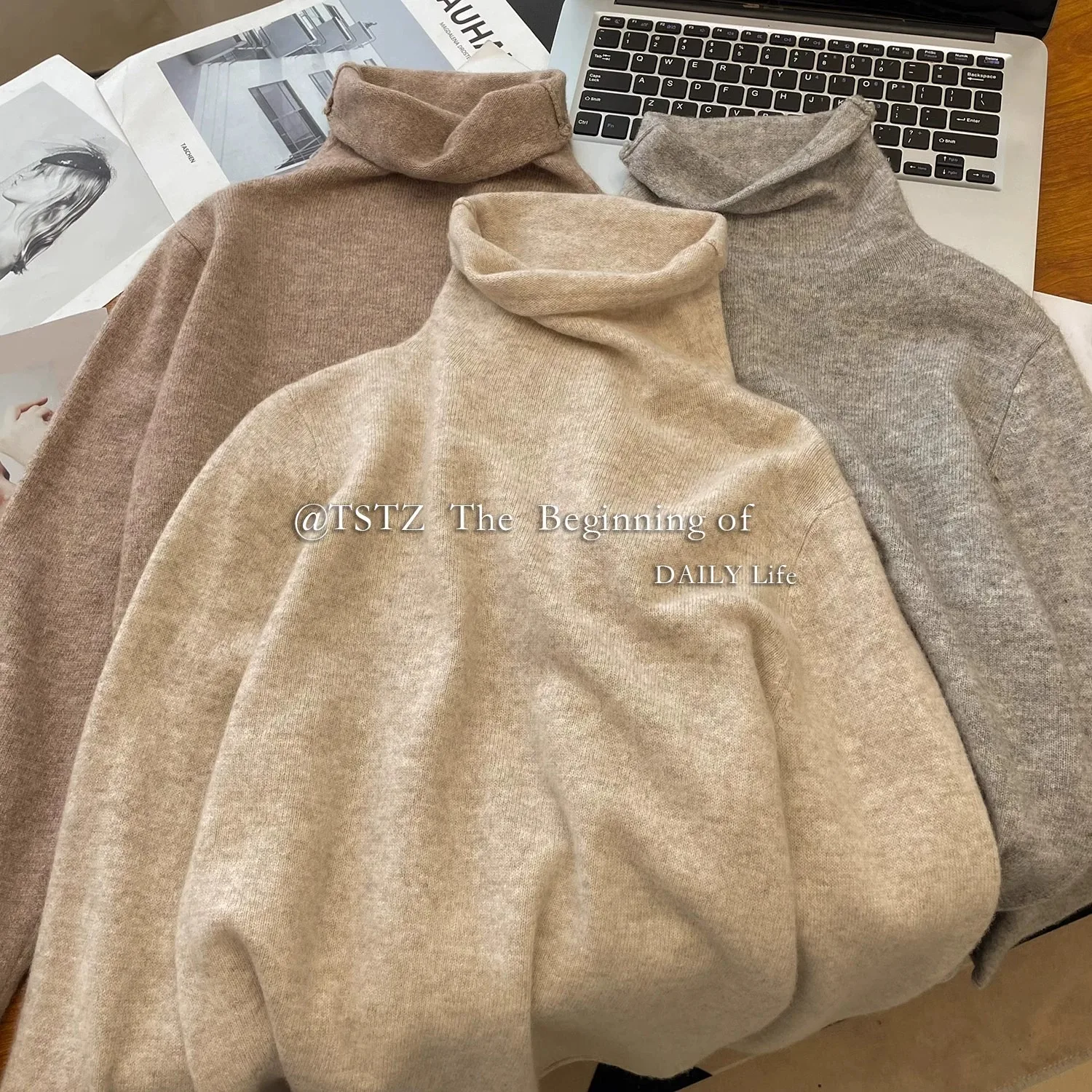
Cashmere Gauge vs. Ply: Clearing the Confusion
Gauge and ply are frequently confused but represent entirely different aspects of cashmere construction. Understanding the distinction helps clarify what makes quality cashmere special:
Ply refers to the number of individual yarn strands twisted together to form the thread used in knitting. A 2-ply cashmere yarn consists of two strands twisted together, while 4-ply uses four strands. More plies typically create stronger, warmer yarn with greater durability.
Gauge, as we’ve established, indicates knitting density – the number of stitches per inch. Gauge is about fabric construction, while ply is about yarn construction.
Here’s where confusion often arises: the same 2-ply cashmere yarn can be knitted at 7-gauge (creating a chunky sweater) or at 12-gauge (creating a medium-weight garment). Similarly, a 4-ply yarn might be used in different gauge settings for varying results. The perfect yarn weight for cashmere sweaters often depends on both ply and gauge working in harmony.
Both specifications matter for quality assessment, but they measure different things. Premium cashmere combines appropriate ply selection with ideal gauge settings to achieve specific performance characteristics. Neither higher ply nor higher gauge automatically indicates superior quality – it’s about using the right specifications for the intended purpose.
Most Common Cashmere Gauge Numbers and Their Applications
3-5 Gauge (Chunky)
– Characteristics: Extremely heavyweight with pronounced, visible stitches that create dramatic texture. The fabric has substantial thickness and a bold, dimensional appearance.
– Best uses: Statement outerwear, chunky winter scarves, and bold cold-weather accessories. These pieces make visual and textural statements while providing exceptional warmth.
– Warmth level: Maximum insulation, ideal for severe cold. The larger stitches create air pockets that trap body heat effectively.
– Durability factors: Highly resistant to wear-through but more prone to snagging due to prominent stitch loops.
7 Gauge (Medium-Heavy)
– Characteristics: Substantial feel with clearly visible stitching and a structured silhouette. Maintains shape well and provides a classic, robust knit appearance.
– Best uses: Traditional winter sweaters, robust cardigans, and cold-weather staples that require both warmth and structure.
– Balance of warmth and versatility: Excellent thermal properties while maintaining enough flexibility for everyday wear. Adapts well to variable temperatures.
– Durability: Strong overall durability with good resistance to both wear-through and moderate resistance to snagging.
9-12 Gauge (Medium)
– Characteristics: The “Goldilocks” of cashmere – not too heavy, not too light. Features balanced properties with moderate stitch visibility and a traditional sweater weight.
– Best uses: Versatile everyday knitwear, year-round pieces, and adaptable garments that transition between seasons.
– Optimal blend: Provides reliable warmth without bulk, and reasonable drape without excessive delicacy. The most universal gauge range.
– Durability: Well-balanced resistance to most wear factors, making these pieces excellent investments for long-term use.
14-16 Gauge (Fine)
– Characteristics: Lightweight with a smooth surface, elegant drape, and minimal stitch visibility. Creates a refined appearance with fluid movement.
– Best uses: Sophisticated layering pieces, lightweight sweaters for temperate climates, and business attire requiring polished presentation.
– Enhanced properties: Exceptional softness and drape, with moderate warmth suitable for indoor environments or mild outdoor conditions.
– Durability: Requires more careful handling but resists pilling well when made with high-quality long fibers.
18+ Gauge (Ultra-Fine)
– Characteristics: Extremely fine with an almost silk-like hand feel, exceptional drape, and virtually invisible stitch pattern. Creates the most refined cashmere experience.
– Best uses: Luxury scarves, summer-weight cashmere pieces, elegant accessories, and premium garments where sensory experience is paramount.
– Maximum refinement: The ultimate expression of cashmere’s natural softness and fluidity, with light insulation suitable for layering or milder conditions.
– Durability: Most delicate gauge requiring careful handling, but when properly cared for, creates heirloom-quality pieces that maintain their exceptional hand feel.
Our cashmere turtlenecks collection showcases various gauge applications, allowing you to experience these differences firsthand.
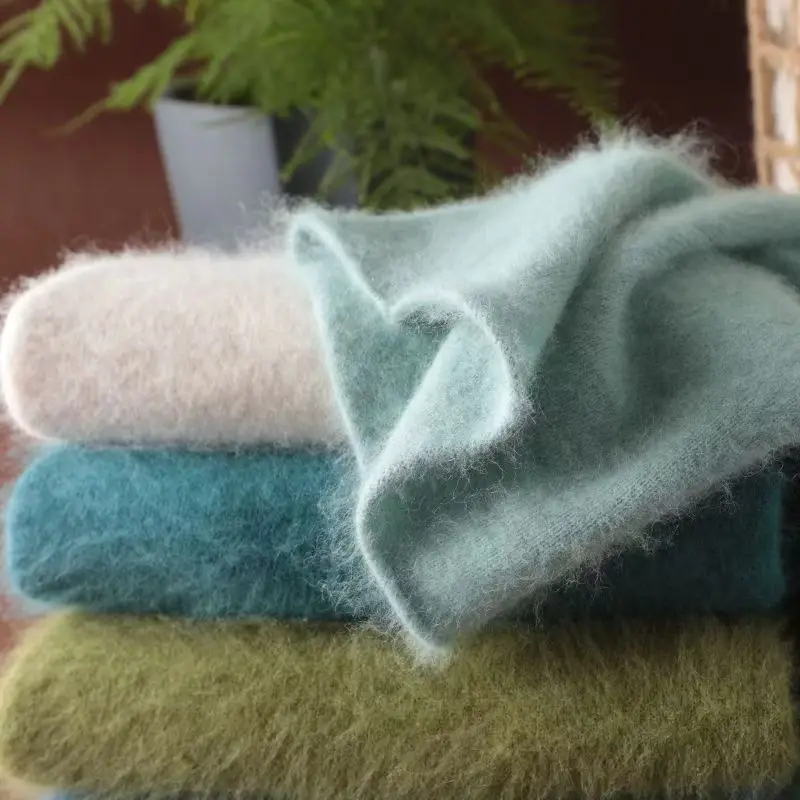
Gauge and Premium Cashmere Quality: What to Know
It’s crucial to understand that gauge itself is a specification, not an inherent quality indicator. The misconception that “higher gauge always means better quality” leads many consumers astray. In reality, gauge is simply the right tool for a specific purpose – like choosing the appropriate knife from a chef’s collection.
Premium cashmere quality begins with exceptional raw materials. Grade A cashmere fibers (under 16 microns) display their luxurious properties regardless of gauge, though those properties express differently across the gauge spectrum. A 7-gauge sweater made with superior cashmere will outperform a 14-gauge sweater made with inferior fibers in both feel and longevity.
Longer cashmere fibers (exceeding 36mm) contribute significantly to performance across all gauge settings. These longer fibers reduce pilling, enhance softness, and improve durability regardless of whether they’re knitted into chunky or fine gauge garments. The ability to judge cashmere quality by touch develops as you experience how premium fibers perform at different gauges.
Different gauges serve different purposes – a chunky 5-gauge cashmere coat provides incomparable winter warmth, while an 18-gauge scarf offers unmatched elegance for formal occasions. Neither is inherently “better” than the other; they simply excel in different contexts.
The true mark of exceptional cashmere is how it performs relative to expectations for its gauge category. A premium 7-gauge sweater should offer superior warmth, softness, and durability compared to average 7-gauge competitors, just as a fine 16-gauge piece should display exceptional drape and handle.
How to Choose the Right Cashmere Gauge for Your Needs
Climate Considerations: Your local weather should significantly influence gauge selection. For harsh winters in northern regions, 3-7 gauge provides substantial protection against extreme cold. Moderate climates benefit from versatile 9-12 gauge pieces that adapt to temperature fluctuations. Warmer regions or indoor-focused wardrobes might prioritize 14+ gauge for lightweight comfort.
Style Preferences: Gauge dramatically affects aesthetic expression. Lower gauges create bold, textural statements with visible stitch definition – perfect for casual, relaxed environments or making strong fashion statements. Higher gauges produce refined, smooth surfaces ideal for elegant occasions or professional settings where subtle sophistication matters.
Intended Use: Consider how and where you’ll wear the piece. Outdoor activities demand the durability and warmth of 7-12 gauge. Office environments often favor the polished appearance of 12-16 gauge. Special occasions might call for the luxurious refinement of 16+ gauge accessories or garments.
Longevity Expectations: Different gauges require different care commitments. Lower gauges typically offer greater resilience to everyday wear but may stretch more easily. Mid-range gauges (9-12) often provide the best balance of durability and refined appearance. Finer gauges deliver exceptional elegance but require more careful handling to maintain their beauty.
Personal Comfort: Perhaps most importantly, your subjective preference should guide your choice. Some people find chunky knits comfortingly substantial, while others prefer the lightweight embrace of fine gauge cashmere. Our oversized cashmere sweaters collection offers excellent examples of how gauge influences both comfort and style.
Cashmere Wrap Sweaters, Women's Cashmere Pullovers
$75.89 Select options This product has multiple variants. The options may be chosen on the product pageCashmere Cable Knit Sweaters, Women's Cashmere Pullovers
Price range: $111.82 through $112.93 Select options This product has multiple variants. The options may be chosen on the product pageCropped Cashmere Sweaters, Women's Cashmere Pullovers
$155.77 Select options This product has multiple variants. The options may be chosen on the product pageOversized Cashmere Sweaters, Plus Size Cashmere Sweaters, Women's V-Neck Cashmere Sweaters
$136.87 Select options This product has multiple variants. The options may be chosen on the product page- Price range: $108.11 through $130.03 Select options This product has multiple variants. The options may be chosen on the product page
Striped Cashmere Sweaters, Women's Cashmere Pullovers
$139.68 Select options This product has multiple variants. The options may be chosen on the product page
Caring for Different Gauge Cashmere
While all cashmere benefits from gentle care, different gauges have specific maintenance needs:
General Cashmere Care Principles:
– Hand wash with cold water and mild cashmere shampoo
– Never wring or twist wet cashmere
– Dry flat on a clean towel away from direct heat or sunlight
– Store clean, folded with cedar blocks or lavender sachets to deter moths
Chunky Knits (3-7 gauge):
– Reshape more aggressively when wet as these are prone to stretching
– Dry completely before storing to prevent mildew in denser areas
– Avoid hanging as weight can distort the more open knit structure
– Use sweater combs with extra caution on the larger stitches
– Allow more space in storage to maintain structure
Medium Gauge Items (9-12 gauge):
– Balance reshaping without stretching during drying
– May benefit from light steam rather than iron pressing
– Can handle gentle sweater combs for pill removal
– Store folded with tissue paper between folds for structure
– Rotate wear to allow recovery between uses
Fine Gauge Cashmere (14+ gauge):
– Handle with extra care when wet as delicate stitches are vulnerable
– Use mesh washing bags to reduce friction during cleaning
– Avoid any pulling or tugging on the fine stitches
– Store folded with minimal creasing to prevent permanent marks
– Consider using fingertips rather than combs for pill removal
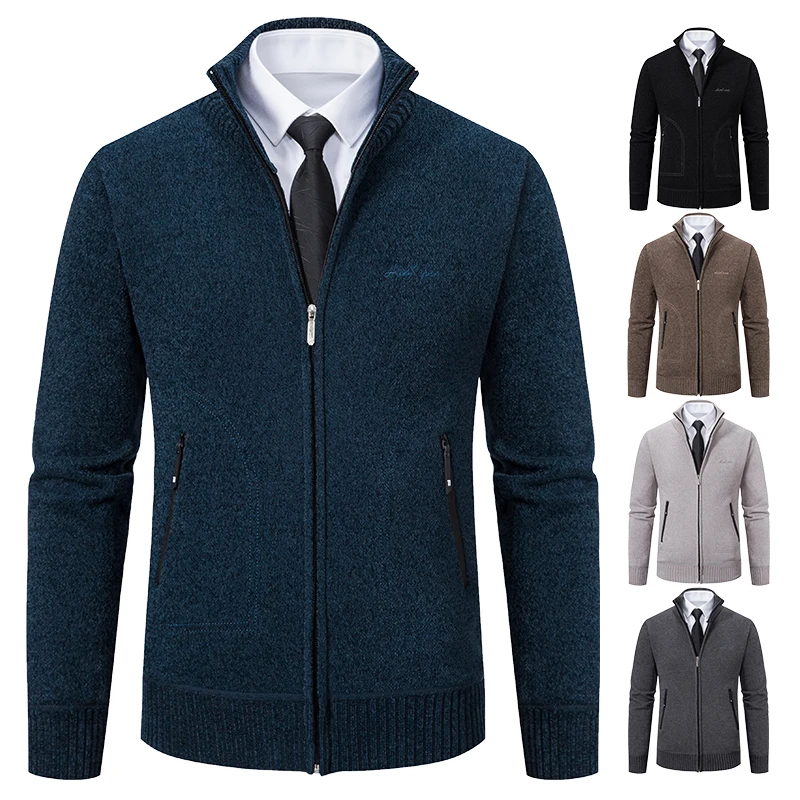
Our cashmere cable knit sweaters demonstrate how gauge interacts with complex knit patterns, each requiring specific care approaches to maintain their distinctive structures.
Common Questions About Cashmere Gauge
Does higher gauge mean better quality?
No. Gauge is a specification, not a quality indicator. A well-made 7-gauge sweater from excellent cashmere fibers will be superior to a poorly-made 16-gauge sweater from inferior fibers. Quality depends on the raw materials and manufacturing expertise, not the gauge number itself.
How does gauge affect pilling resistance?
The relationship is complex. Tighter knits (higher gauge) can show pilling more visibly due to increased friction points, but if made with premium long fibers, they may resist pilling well. Looser knits sometimes allow fibers more movement, reducing friction at certain points. Fiber quality is typically more important than gauge for pilling resistance.
Can gauge numbers vary between manufacturers?
Yes. While industry standards exist, slight variations in measurement techniques or regional traditions can mean that one brand’s 12-gauge might feel similar to another’s 14-gauge. Trust your hands as well as the number.
How does gauge affect price?
Higher gauge pieces often require more sophisticated machinery and longer production times, potentially increasing costs. However, chunky lower gauge pieces may use more cashmere by weight, also affecting price. The most expensive isn’t necessarily the highest gauge – it’s about appropriate materials and craftsmanship for the intended design.
Should gauge influence my purchasing decision?
Absolutely, but based on your needs rather than assumptions about quality. Choose gauge based on intended use, climate, and personal preferences. The stylish ways to wear cashmere cardigans often depend on selecting the right gauge for specific outfits and occasions.
The Gauge-Fiber Quality Connection: What Makes Truly Premium Cashmere
Exceptional cashmere begins with the raw material. Premium cashmere starts with fibers under 16 microns in diameter – the Grade A standard that ensures fundamental softness regardless of gauge. These ultrafine fibers perform beautifully across the gauge spectrum, though they express their luxury differently at each setting.
The length of cashmere fibers is equally crucial. Longer fibers (exceeding 36mm) create stronger yarns that resist pilling and maintain their integrity through washing and wearing. When these superior long fibers are knitted at any gauge, they create garments with exceptional performance characteristics specific to that gauge’s intended purpose.
Proper manufacturing enhances gauge-specific properties. Expert tension control during knitting ensures that a 7-gauge sweater maintains its structure while a 16-gauge piece achieves perfect drape. Skilled finishing techniques bring out the best in each gauge – from defined stitch patterns in chunky knits to flawless surfaces in fine gauge pieces.
Estate Cloth selects raw cashmere that performs exceptionally across various gauges. Our men’s cashmere pullovers showcase how premium fibers express differently at various gauges while maintaining consistent quality standards.
Final Thoughts: Beyond the Numbers
Understanding cashmere gauge numbers transforms you from a passive shopper into an informed connoisseur. Rather than viewing gauge as a simple quality ranking, recognize it as a spectrum of possibilities, each offering unique benefits for specific purposes.
The ideal cashmere piece balances technical specifications with personal needs. A 7-gauge sweater isn’t “worse” than a 16-gauge one – it’s simply designed for different circumstances. The knowledge you’ve gained allows you to match gauge characteristics with your lifestyle, climate, and preferences.
As you build your cashmere collection, appreciate how different gauges complement each other. The chunky cardigan for weekend retreats, the mid-gauge pullover for everyday versatility, and the fine gauge turtleneck for professional settings work together to create a complete cashmere wardrobe.
Beyond all the technical specifications, the true joy of cashmere comes from the sensory experience and enduring pleasure of wearing exceptionally crafted pieces. With your new understanding of gauge, you can fully appreciate the craftsmanship behind each stitch of these remarkable garments.

